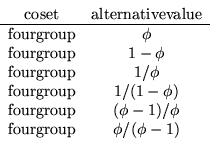It should be realized that any number at all, including infinity and negative numbers, could be a cross ratio, similar to the observation that any positive number could be the radius of a circle. It is just that a cross ratio is the invariant for projections, whereas radius is the invariant for rotations in another kind of space.
It is of combinatorial interest to recognize that the ordering of the points in the definition of the cross ratio is likely to change its value, although any of the ![]() orderings is just as useful as any other. As it works out, the simultaneous exchange of both members of two pairs (the permutation
orderings is just as useful as any other. As it works out, the simultaneous exchange of both members of two pairs (the permutation ![]() ) fixes the cross ratio. As they generate a normal subgroup of order four of the tetrahedral group, there are six equivalence classes of alternative values for the cross ratio itself.
) fixes the cross ratio. As they generate a normal subgroup of order four of the tetrahedral group, there are six equivalence classes of alternative values for the cross ratio itself.

Another reduced set of values results from
![]() , which leads to
, which leads to
![]() , or
, or
![]() , complex cube roots of unity, two of which comprise the orbit of this symmetry.
, complex cube roots of unity, two of which comprise the orbit of this symmetry.